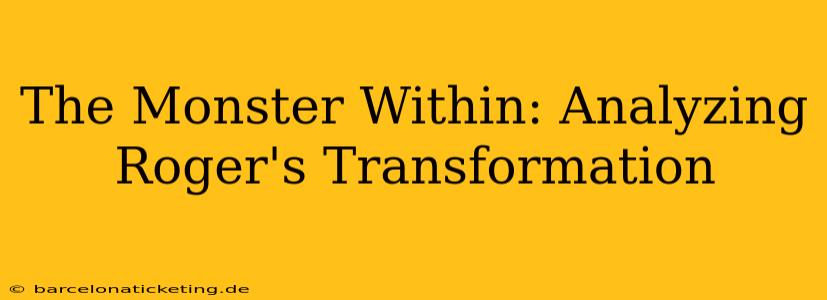William Golding's Lord of the Flies isn't just a chilling tale of boys stranded on a desert island; it's a profound exploration of human nature's inherent darkness. At the heart of this exploration lies Roger, a character whose transformation from a somewhat shy, initially restrained boy to a brutal, savage figure embodies the novel's central themes. This essay will delve into Roger's disturbing metamorphosis, examining the factors that contribute to his descent into savagery and the symbolic significance of his actions.
What Drives Roger's Transformation?
Roger's transformation isn't sudden; it's a gradual descent fueled by several intertwined factors. Initially, he's presented as a character on the periphery, somewhat withdrawn and seemingly less involved in the boys' initial attempts at civilization. However, the island's isolation and the boys' gradual abandonment of societal norms create fertile ground for his darker impulses to flourish. The lack of adult supervision, coupled with the increasing influence of Jack's tribalism, provides the perfect environment for Roger's inherent cruelty to manifest.
The Breakdown of Civilization
The disintegration of the boys' attempts to establish a civilized society is a crucial catalyst in Roger's transformation. As the boys descend into chaos and savagery, the constraints of societal rules and moral codes begin to erode. This gradual breakdown removes the external restraints that had previously kept Roger's darker impulses in check. The absence of consequences for his actions emboldens him, allowing his inherent savagery to emerge unchecked.
The Influence of Jack's Tribalism
Jack's charismatic yet manipulative leadership plays a significant role in Roger's transformation. Jack preys on the boys' primal instincts, channeling their fears and frustrations into a tribalistic fervor. Roger, initially hesitant, is gradually drawn into Jack's tribe, finding a sense of belonging and acceptance within its brutal structure. Jack's acceptance validates Roger's darker instincts and provides a framework for their expression.
The Power of the Setting
The island itself acts as a potent symbol, representing both the potential for beauty and the inherent dangers of untamed nature. The island's isolation and wildness strip away the veneer of civilization, allowing primal instincts to surface. The wild landscape mirrors the boys' own internal struggles, providing a fertile ground for their descent into savagery. Roger, in particular, seems to find a strange comfort and freedom in the untamed environment, using it as a backdrop for his increasingly violent actions.
Is Roger Inherently Evil?
This leads us to a crucial question: is Roger inherently evil, or is his transformation a product of his environment and circumstances? While Golding doesn't explicitly answer this question, the novel strongly suggests that Roger's savagery is a result of both internal predispositions and external pressures. His actions are certainly horrific, but the novel subtly implies that the island's isolating environment amplified already existing tendencies. It’s a complex interplay of nature and nurture, making Roger a tragically compelling figure.
How Does Roger's Transformation Reflect the Novel's Themes?
Roger's transformation serves as a powerful microcosm of the novel's broader themes. His descent into savagery mirrors the boys' collective fall from grace, highlighting the fragility of civilization and the ease with which it can crumble in the face of primal instincts. His actions serve as a stark reminder of the inherent capacity for evil that exists within humanity, even in seemingly innocent young boys.
The Loss of Innocence
Roger's transformation also encapsulates the novel's exploration of the loss of innocence. The idyllic setting of the island initially suggests a sense of freedom and adventure. However, as the boys abandon their attempts at civilization, their innocence is progressively eroded, culminating in Roger's brutal acts. His transformation represents a complete loss of innocence, mirroring the overall decline into savagery experienced by the group.
The Power of Fear and Violence
Finally, Roger's story illustrates the corrosive effects of fear and violence. As the boys become increasingly fearful and violent, their actions feed a cycle of escalating brutality. Roger's actions are a culmination of this cycle, representing the ultimate expression of the unchecked power of fear and violence.
In conclusion, Roger's transformation in Lord of the Flies is a complex and disturbing journey that reveals the unsettling potential for savagery lurking beneath the surface of even the most seemingly innocent individuals. His actions serve as a powerful symbol of the fragility of civilization and the profound consequences of abandoning moral principles. Understanding Roger's transformation allows for a deeper understanding of the novel's enduring message about the inherent darkness within humanity.

